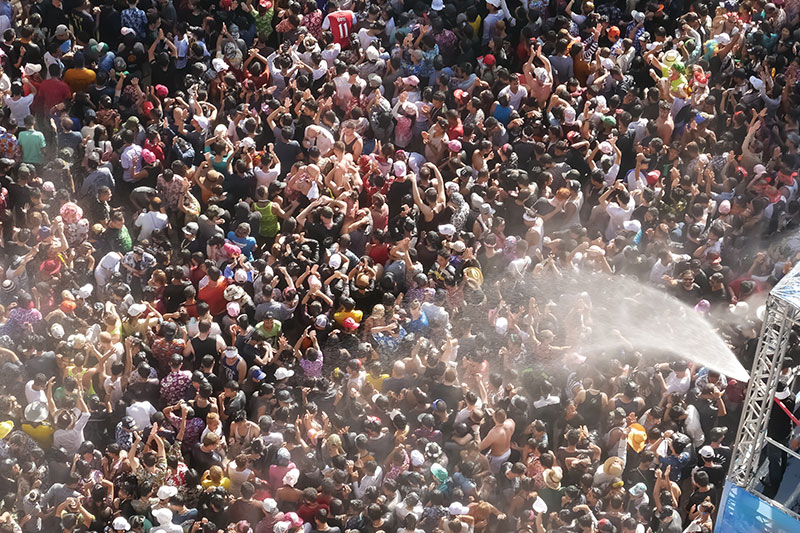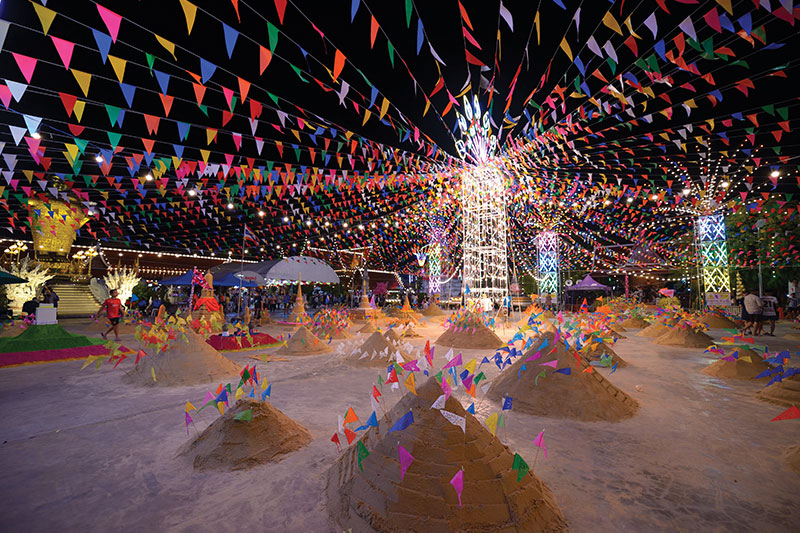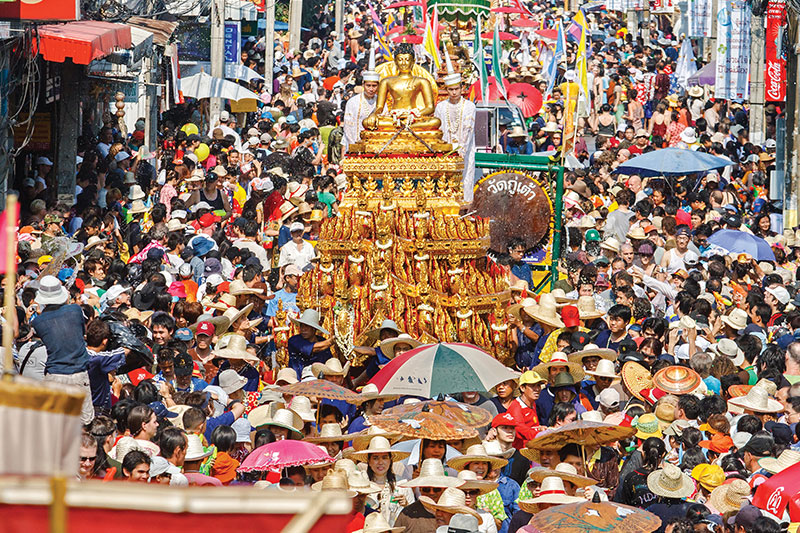
Songkran: Go with the Flow
Dive deep into the sacred traditions and splashing fun of Thailand’s traditional New Year festival
Words: Pattarawadee Saengmanee
Photos: Shuterstock
Songkran, Thailand’s traditional New Year, blends sacred rituals, family reunions, and joyful water fights in a nationwide celebration of Thai culture. Locals join temple ceremonies and enjoy family reunions before hitting the streets for lively water-splashing battles. Playful, ancient, and sacred, Songkran was added to UNESCO’s Intangible Cultural Heritage list in 2023.

The Roots of Songkran
According to legend, Theravada Buddhist monks from Sri Lanka introduced the New Year celebratory tradition to Southeast Asia. Songkran has retained a Buddhist flavour ever since, most notably in the bathing of Buddha statues.
Thailand’s New Year was officially designated as April 1 during King Rama V’s reign (1868-1910). However, in 1941 it was shifted to January 1 to match the global calendar, while the traditional Songkran celebration was moved to April 13-15.
A stone inscription at Wat Pho in Bangkok recounts the mythic origins of Songkran, Thailand’s traditional New Year celebration. The tale revolves around Dharmapalakumar, a prodigious child born to a wealthy man after years of prayers to the Sun and Moon. Gifted with knowledge, he was challenged to answer a riddle by the god Kabil Maha Phrom – with the loser forfeiting his head.
Kabil Maha Phrom is one of the celestial Brahma deities in Thai mythology, linked to cosmic wisdom and balance. In Thai tradition, ‘Phrom’ refers to divine beings associated with Brahma, the Hindu creator god, though they are not incarnations of him. His challenge was not just a test of intelligence but a reflection of the nature of human vitality and the passage of time.
The god’s riddle was: “Where is the glory of men located in the morning, afternoon, and evening.”
Despite his intelligence, Dharmapalakumar struggled to find the answer. As the deadline approached, he wandered into a forest, seeking inspiration. There, he overheard an eagle speaking to its make, unknowingly revealing the solution to the riddle. The eagle said:
“In the morning, the glory of men is on the face, as people wash and groom themselves to start the day, presenting their best selves to the world.
“In the afternoon, it is on the chest, where the heart beats strongest, driving energy, determination, and effort.
“In the evening, it is on the feet, which have carried a person through their daily journey and now seek rest and relief.”
The answers reflect traditional Thai beliefs about human vitality and the rhythms of daily life- how a person’s energy shifts throughout the day, emphasising renewal in the morning, action in the afternoon, and rest in the evening.
Armed with this knowledge, Dharmapalakumar confidently recited the answers to Kabil Maha Phrom, winning the challenge.

Bound by his own oath, the god was forced to decapitate himself. However, his severed head held immense destructive power – if it touched the ground, the earth would burn; if it fell into the sea, the waters would dry up, and if left in the sky, it would unleash an inferno. To prevent catastrophe, his seven celestial daughters took turns carrying his head in an annual heavenly procession.
This celestial ritual came to symbolise the passage of time and the arrival of a new year. Each year, a different daughter carries the head, mirroring the continuous cycle of time, renewal, and transition from one year to the next. Much like the old year making way for the new, the procession ensures cosmic balance, reflecting Songkran’s deeper meaning as a festival of purification, renewal, and new beginnings – values that continue to shape Thai culture today.
Across Thailand, Songkran’s religious roots extend to Buddhism, with the bathing of Buddha statues, while ethnic communities observe their own unique customs. In Sukhothai’s Thai Puan communities, a vibrant elephant procession carries novice monks for a mass ordination, re-enacting the journey of Prince Vessantara, an incarnation of the Buddha.

Traditions and Beliefs
Songkran marks the end of the harvest, offering farmers and all of Thailand a chance to unwind and cool off in the summer heat. Water is the sacred essence of the festival, cleansing the soul through sacred rites and splashing battles.
People start the New Year by cleaning their homes to ward off bad luck. The morning is devoted to making merit, bathing Buddha images, and building sand pagodas in temples. At home, young family members pour jasmine-scented water over their elders’ hands, seeking their blessing.

Songkran Today
While its sacred essence remains unchanged, Songkran has evolved into a vibrant nationwide celebration. Beauty pageants, ornately decorated floats, and water guns infuse the festivities with fun, while families reunite in emotional gatherings as people return home from the city.
Northern Thailand parties for four days during the Lanna-style Songkran. People spend the first day cleansing themselves and their homes and lighting firecrackers to chase away bad luck. The second day is for making sand pagodas and visiting friends and family, while the third is devoted to temple merit-making and water blessings for elders. On the final day, people eat golden jackfruit curry to bring prosperity for the year ahead.
Southern Thailand celebrates Songkran with its own traditions, including Tham Kwan Khao, a rice blessing ritual, and the symbolic dressing of new year’s guardian spirit with fresh clothing and accessories.

Top Destinations
Songkran customs differ from place to place, enabling visitors to experience Thailand’s rich cultural diversity.
Samut Prakan’s Phra Pradaeng Songkran Festival showcases Mon traditions in a vibrant procession of swan-like floats and sand pagodas flowing through the streets to Wat Klang Na.
At Kanchanaburi’s Wat Wang Wiwekaram, Mon youngsters feed their parents boiled rice before bathing their hands and building a five-tier sand pagoda.
In Chiang Mai, the revered Phra Phuttha Sihing statue radiates blessings during a street parade. Meanwhile, Tha Phae Gate bustles with beauty pageants, lantern and sand pagoda competitions, and water fights.
Udon Thani celebrates with a water tunnel, retro market, tuk-tuk processions, and cultural performances highlighting its Thai, Chinese, and Vietnamese heritage.
Songkran-inspired festivals are celebrated across South and Southeast Asia, blending Buddhist and Hindu traditions in unique ways.
In Laos, hundreds of monks parade through Luang Prabang showered by devotees’ watery blessings during the Lan Xang-style Pi Mai celebration.
Myanmar’s Thingyan festival is a blend of merit-making, water splashing, and rites honouring elders.
In China’s Yunnan, the Dai community holds boat races, fireworks, and lantern launches. Sri Lanka’s New Year, or Aluth Avurudda, merges Buddhist and Hindu customs as families light oil lamps, offer prayers, and seek blessings from elders.

Songkran Practical Tips
While Songkran is a joyous celebration, taking a few precautions will ensure the fun flows smoothly. A waterproof bag will protect belongings including your phone, allowing you to stay connected during the festivities. Splashing with clean water should prevent skin irritation – but remember to respect the space of people not participating in the battle.

Where to Join the Fun in Thailand
For those staying in Bangkok, Khaosan and Silom Road are the splashing heart of Songkran. From noon to 8pm, both streets are closed to traffic, lined with food vendors, and filled with water warriors.
Meanwhile, beachside splashing and sand pagoda contests are just an hour’s drive from Bangkok, at Bang Saen’s Wan Lai Festival during Songkran.
Wherever you celebrate, Songkran’s mix of sacred rites and splashing fun offers a deep dive into the very best of Thai culture.
